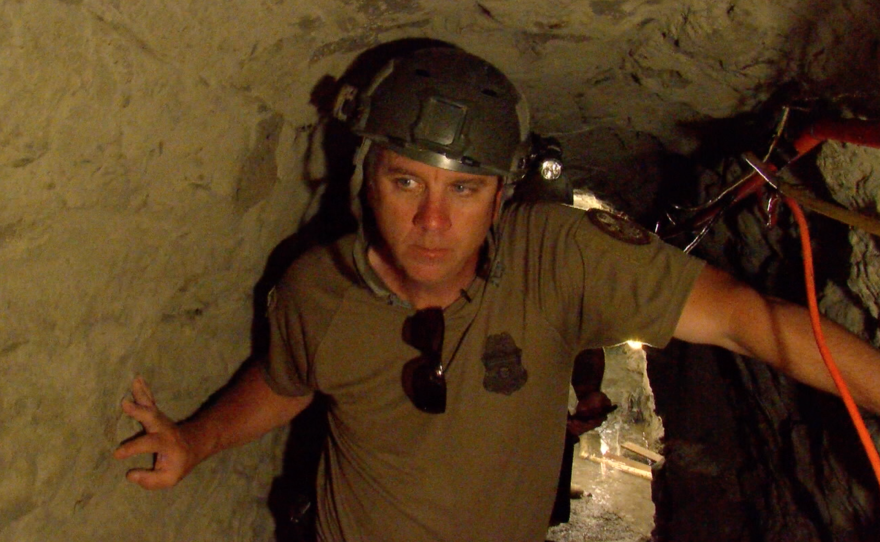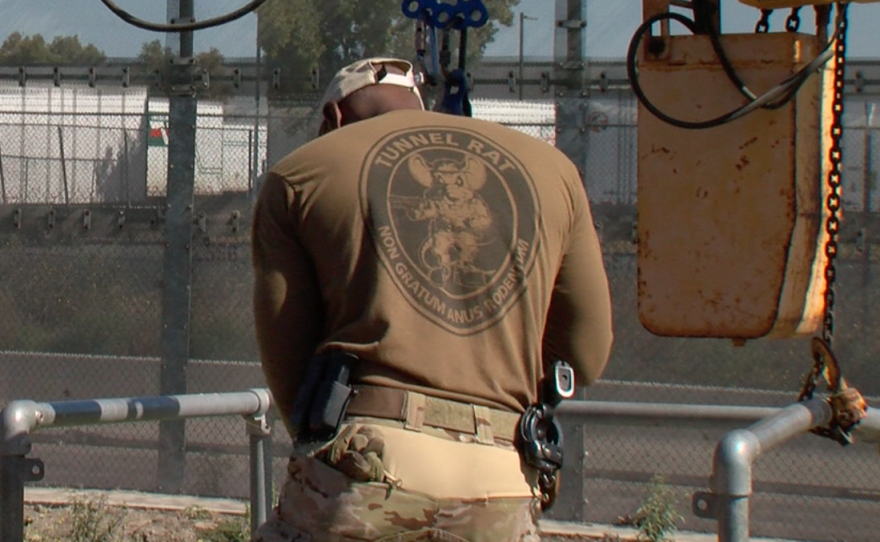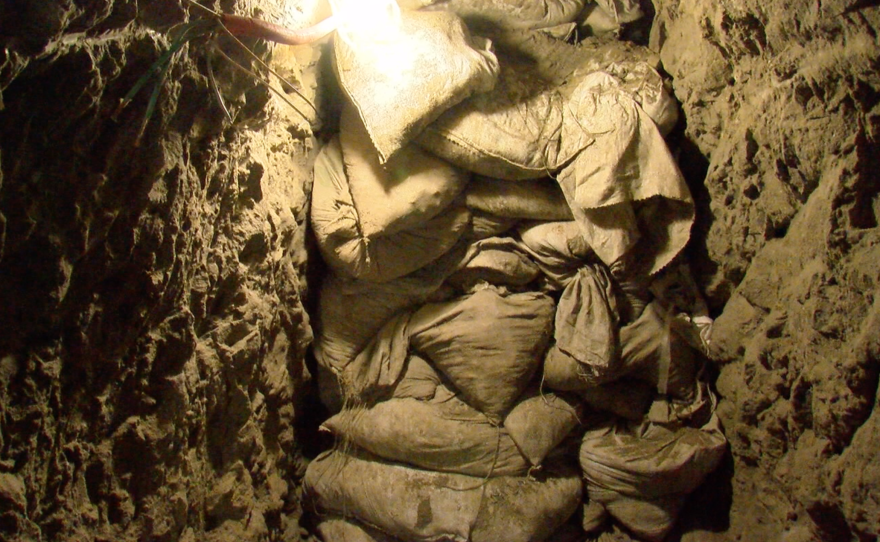Under the corrugated steel plates that divide the U.S. and Mexico in Otay Mesa, dozens of clandestine cross-border tunnels slash through the soil.
As President Trump looks to build new barriers along the border, criminal organizations in Mexico are improving the tunnels they use to smuggle people and drugs under the border fence – making them smaller and maintaining a high level of sophistication, featuring electricity and railways.
Smuggling tunnels vary in shape and size, but generally fall under one of these three categories, according to U.S. Border Patrol:
–Rudimentary tunnels, or “gopher holes,” are cheaply made and stretch short distances, maybe 50 feet. They are used to smuggle humans or small quantities of drugs under the border.
–Interconnecting tunnels exploit existing municipal infrastructure, linking up with storm drains and sewer lines. They are used to smuggle humans and drugs under the border.
–Sophisticated tunnels can stretch for long distances (the longest ever found was equivalent to the length of eight football fields) and are often equipped with lighting, electricity, ventilation, water pumps, railways and more. They are used to move large volumes of drugs under the border.
In San Diego, tunnels are usually sophisticated, partly because of the highly organized criminal organization operating in Baja California – the Sinaloa Cartel – as well as the characteristics of Otay Mesa, a neighborhood that exists on both sides of the border. In the U.S. and in Mexico, Otay Mesa is crowded with warehouses, providing numerous spaces to hide tunnel entry and exit points.
According to the U.S. Border Patrol, in the past three decades, 29 of the 62 sophisticated tunnels that have been found along the U.S.-Mexico border were in the San Diego sector. Meanwhile, of the 197 total tunnels discovered along the border, 62 were in the San Diego sector. These figures exclude about a hundred unfinished tunnels found on the Mexican side of the border.
Drug tunnels began to proliferate in response to increased border security, particularly border fence construction launched in the 1990s, according to U.S. and Mexican researchers.
“The more sophisticated our border infrastructure has become, the more the smugglers have upped their game,” said David Shirk, director of the Trans-Border Institute at the University of San Diego.
Shirk said cartels are going as far as consulting with top engineers in Europe to perfect their tunnel architecture.
“And they have every incentive to do so. If it costs a million dollars to make a tunnel like that, they can make that back on the first run,” he said.
Drug seizures in tunnels are often in the multi-million dollar range, which suggests that cartels are making hundreds of millions of dollars on these tunnels.
The Tunnel Rats Get To Work
Lance Lenoir is captain of Border Patrol’s five-person tunnel entry team, known as the Tunnel Rats. When a tunnel is discovered with an exit in the U.S., the Tunnel Rats get to work.
“What we do is assess the tunnel, characterize it, go in, pull out evidence, map it, get rid of it,” Lenoir said.

By “get rid of it,” Lenoir means they fill the tunnel with cement on the U.S. side of the border – what Border Patrol calls “remediation” of the tunnel. The tunnels often remain open on the Mexican side.
Lenoir said the sophisticated tunnels centered around San Diego are becoming narrower and harder to detect – ranging anywhere from 36 inches to less than four feet in diameter.
So far, the most reliable method of detection has been what Lenoir called “good old-fashioned police work,” with officials pursuing leads from informants who notice suspicious jackhammer sounds, large piles of dirt, or people coming and going at unusual hours. But U.S. federal agencies are now seeking to improve tunnel detection technologies.
Tunnel Detection Technology Is “Lacking”
“We need to bring the technology piece. Right now, it’s lacking,” Lenoir said. “I mean we’re talking about a niche problem that doesn’t have any parallel to commercial or industry standard.”
Existing technology – ranging from ground-penetrating radar to sensors that detect changes in microgravity – gets thrown off by surface clutter and noise, and there is a lot of cross-border traffic in this area. Radio and electromagnetic interference is another problem. Heterogeneous geology along the U.S.-Mexico border – a mix of porous, sandy and rocky – also makes it hard to see what is underground.
Lenoir said he does not know if plans to expand the border fence will affect tunneling. But the cartels keep getting more creative in making tunnels, and he said he wants to make sure the U.S. gets more creative in finding them.
“You can’t go to Wal-Mart and buy those things – so that’s what we’re working on actively right now,” Lenoir said.
The Galvez Tunnel Remains Open
About 90 feet under Otay Mesa, footsteps from the Cross Border Xpress bridge that connects San Diego and Tijuana, lies a drug tunnel about six feet high and four feet wide, with lighting and ventilation.
It is called the Galvez Tunnel. Unlike most tunnels discovered in the U.S., this one was left partly open to train the Tunnel Rats. It used to have a rail system for transporting cocaine, marijuana and other drugs. U.S. investigators found the tunnel before it was finished.
On a recent Monday, the Tunnel Rats opened it up to give reporters a tour. Lenoir wore a tan shirt with an illustrated cartoon rat on the back.

“This is like the Cadillac of tunnels,” he said, placing a hand on the sandstone walls, which did not require shoring with cement because they were naturally stable.
Despite the tunnel’s sophistication, tool marks along the walls show it was made with a mere hammer drill, like most tunnels.
“Pure manual labor. Blood, sweat and tears,” Lenoir said.
Cartels Get Creative
Some of the most creative elements of drug tunnels involve the way cartels disguise the entry and exit points. The Galvez Tunnel is a good example of that creativity.
“This one in particular was hid under a bathroom floor that actually raised and lowered to get in and out. We’ve seen elevators, bonafide elevators with up and down buttons, everything but the music,” Lenoir said.

For ventilation, criminal groups often utilize things like leaf blowers and floor dryers.
“My personal favorite is the bounce house blower,” Lenoir said. “Very ingenious.”
The creativity of the tunnels is consistent with Mexican drug cartels’ way of overcoming the border fence above-ground – using catapults, drones and ladders to get the drugs across, for example.
“The cartels are always trying to innovate and respond to challenges in exactly the same way that any other business does,” said Tom Wainwright, author of "Narconomics," and Britain editor for The Economist. “The message seems to be that whatever technology is used on the U.S. side, the cartels are going to counter with technology of their own.”
Jose Manuel Valenzuela, an investigator for the Mexican border research institute El Colegio de la Frontera Norte, said he does not think tunnel detection technology will ever be good enough to prevent the problem.
If the U.S. and Mexican governments really want to stop drug tunnels, Valenzuela said, they need to chase the massive profits they generate – in the banks. He said that with existing regulatory regimes, banks are a blind spot for authorities on both sides of the border.
“That’s the large tunnel of the drug market – the banks,” he said. “Until we look at that perspective, we’ll keep talking about this game of cat and mouse.”
This is midday edition. As President Donald Trump looks to develop more walls on the border, cartels in Mexico are looking for ways to improve drug smuggling tunnels. Jean Guerrero traveled to the border where she got a firsthand look at how they are changing. I'm hooked to harness about to go underground with the entry team. He wears a brown shirt with a big cartoon racked on the back. We go win and polo evidence and map it. He meets the plug the drug tunnels up with cement but this went was partly intact to train the tunnel rats. U.S. federal agents found the tunnel in 2009 before it was finished. Cartels bolted to smuggle things like pots and cocaine. They tell me to hold on tight. I am fasted to a tether. We had into the tunnel. Deep inside the ground the tunnel is about 6 feet high and 4 feet wide with sandstone walls. It's relatively comfortable although it is warm and humid. This is like the cow lot of tunnels. It is tall, wide, very stable. They classify it as a sophisticated tunnel. It has lights and ventilation and used to have a rail system. There are other kinds of tunnels known as gopher Hills stretched 50 feet. This went was a hid underneath the bathroom for that raised and lowered to get in and out. We've seen elevators. Despite the sophistication marks showed it was made with the hammer drill. Nearly 200 drug tunnels had been found since 1990. Davidson criminal organizations began building them in response to border fence construction. The more sophisticated and elaborate our border infrastructure has become, the more the smugglers have up their game. They have plans to expand the border fence. He says cartels are going as far as consulting the top engineers in Europe to perfect the tunnel architecture. They have every incentive to do so. Most of the sophisticated tunnels are being found around San Diego. That is because there is so many warehouses and Otay Mesa. The tunnel runs under Otay Mesa. Back outside the drug tunnels are getting harder to find. Cartels are making them smaller. They range from 36 inches in diameter to little less than 4 feet. To find the titles they realize -- rely on leads from informants. Border patrol is working to improve tunnel detection technology. Right now it is lacking. We are talking about a problem in here that's not really having any parallel to the commercial standards. Technology gets thrown off by clutter and noise. The mixed geology also makes a Hardisty was underground. They don't know plans to expand the border fence will affect tunnels. The cartels keep getting more creative. You want to make sure the U.S. gets more creative in finding them. She has more to share so she spoke with Metro reporter Andrea Bowen for the podcast series. Here's part of that podcast. So digging the tunnels is more complicated or sophisticated than just taking. They have to have other things to make it possible. Right. Aside from thinking, they have to go in there and make sure that it is safe to pass through these vapors that they have to deal with. So the tunnel rats Captain was explaining about that. They had these PVC pipes in there for ventilation. It is powered by leaf blowers for dryers and that is about it. My personal favorite is the bounce house blower. Very ingenious. They get used to struggle Doug's how about people? They will use tunnels to smuggle people when they were very cheap to make. A lot of shorter tunnels some of the interconnecting tunnels as well because those are pretty cheap to make because they're taking advantage of existing storm drains and sewer lines. They just hook up to. You are seeing the tunnel that the most dangerous are the ones that people are going through. That is right. The ones that are least able. -- Stable. How many tunnel rats are on the team? They like to call themselves tunnel rats. I think they made those shirts. There are only five of them. What do they do when they find an interest to a tunnel question The first thing to do is check to make sure it is safe to go into. I mentioned that conditions earlier they make sure there's nothing poisonous. If it is dangerous to go in, they will make adjustments to the tunnel to make it safe to go into. I actually spoke to the captain about that in a little bit more detail. When it is found, the tunnel team will go win and assess the tunnel make sure it is safe for entry and make corrections or adjustments as needed in order to go in. Then we will map it from start almost to the United States border and that gives us a surface representation on what we are looking at. Will go back in and remap it with precision technology so we can identify the tunnel. Then we will just drill on those marks and throw them in a concrete truck and pull it up. So they map these twice. Why's it so much detail question mark Part of the reason that they do this mapping detail is because they can only fill up the tunnels and plug them up to the U.S. border. Often times the tunnels will remain open on the Mexican side because the Mexican officials -- they don't have enough funding to fill them up. In those cases, we've seen that the cartels will reopen the tunnels but diverting their route. It helps border patrol to know where the existing ones are to have a better idea of where the diverged dust more tunnels can be popping up in the future. Exactly. Trump wants the border wall to stop illegal immigration and the drug trade. What will it do about tunnels question So in the request for proposals that they put out for the wall, the specification said we want a wall that is going to prevent tunneling for at least 6 feet under. That's clearly not going to stop the tunnels. Most of these titles are found dozens of feet below ground. So it doesn't address the problem of tunnels at all. I haven't heard Trump talk about the tunnels directly at all. So 6 feet under the ground what exactly without wall has to do to prevent tunnels from 6 feet and up Westward It could be directly preventing it with actual infrastructure like a wall that goes 6 feet under the ground but then also some of the companies file proposals to build the wall said they would combine that with technology. And it would try to sense any kind of constructions underneath the wall for at least 6 feet. That was Jean Guerrero speaking with Andrea Bowen. You can hear more of that conversation and other conversations by subscribing to San Diego stories which you can find online.






